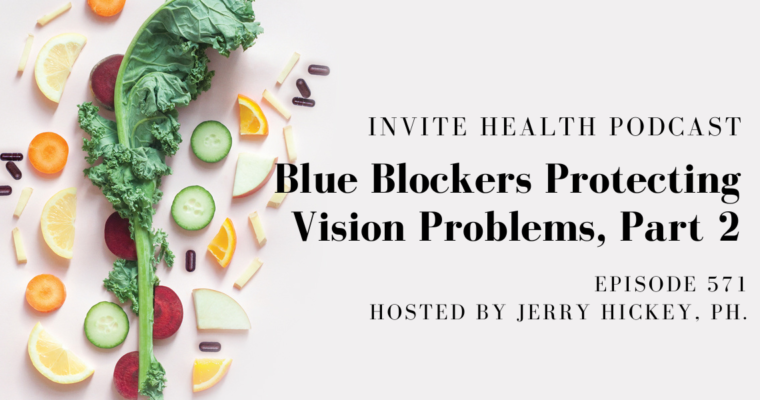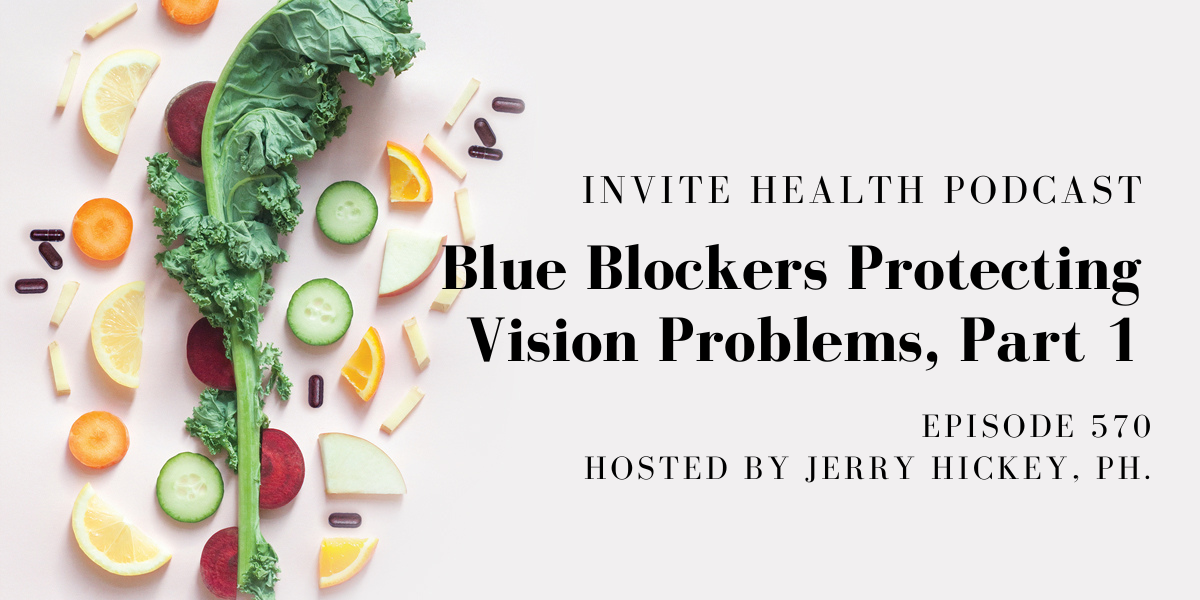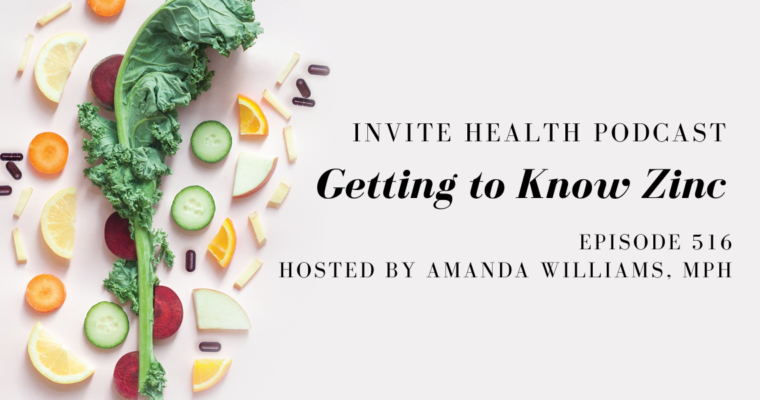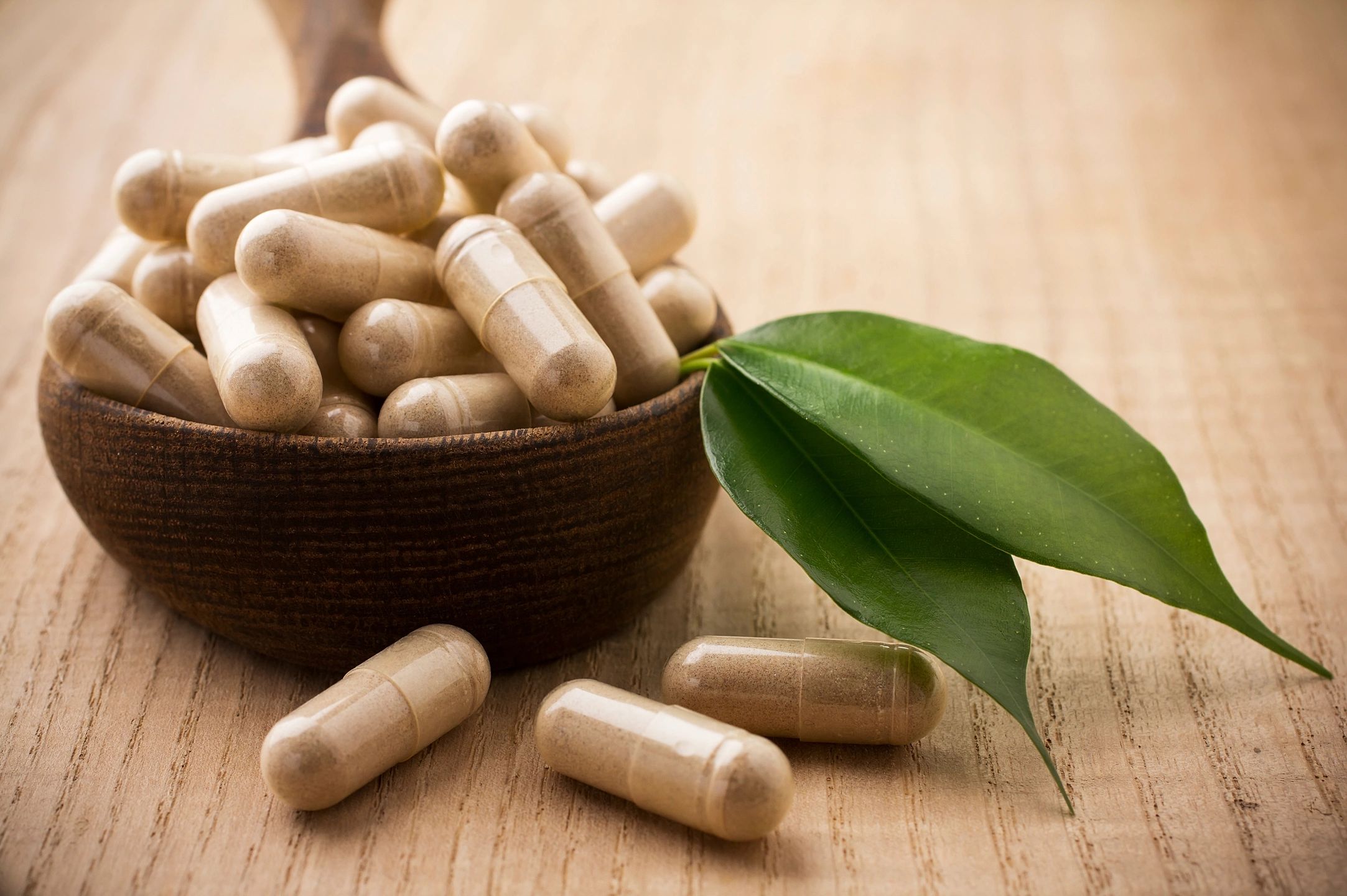Blue Blockers
Subscribe Today!
Please see below for a complete transcript of this episode.
Blue Blockers Protecting Vision Problems, Part 1 – InViteⓇ Health Podcast, Episode 570
Hosted by Jerry Hickey, Ph
*Intro music*
Welcome to the InViteⓇ Health Podcast, where our degreed healthcare professionals are excited to offer you the most important health and wellness information you need to make informed choices about your health. You can learn more about the products discussed in each of these episodes and all that InViteⓇ Health has to offer at www.invitehealth.com/podcast. First time customers can use promo code PODCAST at checkout for an additional 15% off your first purchase. Let’s get started!† Vegetables
*Intro music*
Jerry Hickey, Ph: [00:00:40] I’ve been an advocate for frequent consumption of green leafy vegetables for decades. Based on a lot of science, from leading academic research institutions, and also for supplementing with specific nutrients found in these green leafy vegetables as additional precaution, just to make sure you’re getting enough of these very important nutrients. Now, there’s lots of science, very good quality science, and this is from leading academic research institutions such as Harvard, Tufts, Johns Hopkins. They show that specific nutrients and green leafy vegetables are likely the nutrients that help protect you. And this helps protect you for many things. Many things that occur increasingly with aging, such as memory loss, vision problems, even eye diseases, cancer, bone loss, losing muscle, a condition called sarcopenia, severe loss of muscle and strength, Alzheimer’s disease. And this really seems to be even more relevant for women than men. Don’t get me wrong, it’s very important for men, but it seems to be crucial for women. And we’ll go into the whys of this over the course of this episode.† [00:02:00]
[00:02:03] Now, when I say that there are specific nutrients from the foods that are likely the major players in health. This is based on studies of the foods, but also separate studies of the † and it’s turning out some of these nutrients are a winner. So I’ll explain this some more, by the way, in my episode and welcome to my episode. Blue Blockers Protect You From Vision Problems and Alzheimer’s Disease.† [00:02:29]
[00:02:29] Hi, my name is Jerry Hickey. I’m a pharmacist who specializes in nutrition. By the way, all of our episodes are available for free wherever you listen to podcasts or just go to invitehealth.com/podcast, please subscribe or leave us a review if you listen. You can also find us on Facebook, Twitter and Instagram at InViteⓇ Health. So let’s discuss this. It’s very interesting, by the way.† [00:02:55]
[00:02:57] So a little background on the difference between women and men when it comes to diseases, especially diseases that affect the aging process. Now, in developed countries such as the United States and parts of Europe and Japan, women tend to live longer than men, approximately seven years longer on average. But here’s the paradox, the true gender paradox. Although women tend to live longer, they also have higher rates of diseases and illnesses that are not just tied into living longer. Take, for instance, neurological diseases, those associated with aging. Parkinson’s disease is a disease that occurs in the back of the brain, a part of the brain that controls your balance and your mobility and your muscle function, etc. Parkinson’s disease is more common in men. However, for most other neurodegenerative diseases, women suffer more frequently, but they also suffer at an earlier age. † [00:04:05]
[00:04:10] So even after accounting for lifespan, the longer life span those seven years difference in lifespan for women, women have a higher incidence of Alzheimer’s disease and also the other forms of dementia. Women represent approximately two thirds of all cases of dementia. Age related macular degeneration is the most common cause of vision loss and blindness in aging people and people over the age of 55. Let me explain briefly what this is. In the back of the eye, we have a retina and a retina has all of these delicate, vulnerable little organs that could be damaged. So they have to be shielded and they’re shielded by this protective barrier called your macular tissue, but the macular tissue is more than that fine vision occurs in it and a little egg yolk shaped spot called a fovea. So the macula helps prevent blue light from penetrating into the back of the eye. We’ll discuss blue light a little bit more when we get into the eye specifically. First, we’re going to touch on neurological conditions like Alzheimer’s. Then we’re going to discuss the eye. † [00:05:18]
THIS GENE INCREASES THE RISK OF ALZHEIMER’S; HOW TO FIGHT BACK – INVITE HEALTH PODCAST, EPISODE 301 >> LISTEN NOW
[00:05:20] So what happens in age related macular degeneration? And it’s something that occurs over time. It doesn’t go to an extreme case generally right away. But there’s thinning of the macular tissue and blue light waves are penetrating into the back of the eye and are damaging the retina and it can literally cause loss of central vision. About 70% of all patients with age related macular degeneration are women. This is according to the Journal of Alzheimer’s Disease. They even call it Alzheimer’s of the eyes. There’s studies calling macular degeneration. Alzheimer’s of the eyes. Now, this is a little bit different. Autoimmune diseases, there’s lots of them. The most commonly known ones are multiple sclerosis. That causes damage in the nervous system of the spine and brain. Rheumatoid arthritis, an autoimmune disease where your immune system is attacking your joints. It’s very disfiguring. It’s very painful. Systemic lupus erythematosus, which can attack your kidneys and your liver and other internal organs. Insulin dependent diabetes, where your immune system is destroying the parts of the pancreas that release insulin. Myasthenia gravis, which is an autoimmune disease of your muscles. Scleroderma and Hashimoto’s thyroiditis, which is probably the most common autoimmune disease where your own immune system is attacking your thyroid. 80% of the sufferers of autoimmune disease are women. Now, although many of these are not fatal, or at least over time, not fatal, they are highly debilitating. Of course, there were new drugs available at this point, but some of those drugs were a little bit scary themselves, but they could be lifesaving. † [00:07:20]

[00:07:21] Now let’s discuss green leafy vegetables and then brain diseases and finally eye diseases. I’m gonna discuss in a minute where men and women store nutrients because there’s a slight variation based on body fat percentage. But let’s talk about green leafy vegetables. Why are they so protective? Why is kale and broccoli and spinach and lettuce? Why are they so good for you? Well, they’re packed with many different kinds of nutrients. Now, some of these are the kind of nutrients that a dietitian would look at, like, B, vitamins, like folate. Folate lowers your risk of cancer. Folate lowers your risk of brain diseases. Vitamin C that hold you together, you connective tissue. But it’s also important for your immune system and your brain. Vitamin E, natural vitamin E, which helps protect your heart, your brain, your liver. Minerals such as magnesium, calcium. Strontium that are important for your bones and potassium, which is important for your bones and your heart health and your blood pressure. Vitamin K1; it’s important for bone health, clean arteries, metabolism. But there’s also some more obscure nutrients like glutathione.† [00:08:47]
[00:08:48] My old friend, Doctor Allan Pressman, wrote a book called The Glutathione Phenomenon. He called Glutathione the Mother of All Antioxidants, which it kind of is because it refurbishes them, recycles them like vitamins C and vitamin E, it keeps them going. So glutathione is dominant in the eyes and brain for protecting it. It’s very important. Sulforaphane you find out in cabbage related vegetables that helps do that helps fight viruses that host protected bacteriophage but it’s very good for helping the liver dispose of toxins and chemicals that’s found in green leafy vegetables. Glucuronic acid that helps protect your colon. That’s found in cruciferous vegetables like broccoli and bok choy and broccoli rabe. Indole-3-carbinol, which has antiviral activities, which is important for women’s breasts and their ovaries and their uterus, and your vulva and men’s prostate found in cabbage, vegetables. We’ve done everything. Basically, I’m discussing right here, we’ve done podcast episodes on and so if you want to look it up, we have it. But there’s really warriors and these vegetables for your vision, your brain and memory and possibly you’re hearing, for instance, natural beta carotene. † [00:10:02]
ARE PUMPKINS HEALTHY? – INVITE HEALTH PODCAST, EPISODE 449 >> LISTEN NOW
[00:10:04] Beta carotene is converted to a form of vitamin A that’s very important for the eyes, for your skin, for your immune system. But beta carotene is also found in the auditory processing part of the brain in abundance, where, you know, you’re you’re you’re translating sounds into words. Lutein and Zeaxanthin and this is where I’m going with this Lutein and Zeaxanthin are warriors for your brain and your vision. If you look at the data on age, variations, Lutein and Zeaxanthin are incredibly important for the brain at any point in your life. And infants date the dominant pigments, they make up about 60% of the pigments in the brain. But in somebody who’s 100 years old, they might only make up 25%. So we need more. We need more. Because I’m going to go into all the things they do for the brain that we know of. It’s really interesting. † [00:11:06]
[00:11:08] Lutein and Zeaxanthin are carotenoids. Carotenoids are pigments in vegetables and fruits that are highly protective of the of the plants, but also of humans. For instance, lycopene is the red stuff in a lot of fruits like tomatoes. And lycopene has been shown to help block a whole bunch of cancers, breast cancer and colon cancer and prostate cancer, just to name a few. But they’re very common cancers. And it’s really good for the heart, you circulatory system and your skin, that’s where it gets into your skin and makes the skin look nice but it also helps protect the skin from the sun. The sun could be a disaster for your skin. Beta carotene you’ve heard of many times. Beta carotene is essential for building your skin and your tissues, you go blind without it, you need it for your vision, it’s important for your immune system. And then there’s Lutein and Zeaxanthin. These are very common carotenoids. And in humans these are very important carotenoids in humans there’s alpha carotene, there’s gamma carotene, there’s vital fluorine, there’s Cryptoxantin and Beta-Cryptoxantin and they’re all important. † [00:12:17]
[00:12:19] Many of these are incredibly powerful, incredibly important antioxidants that protect our health and protect our lifespan. They protect ourselves when we’re converting sugar and oxygen into energy. The little power plants called mitochondria, our cells are loaded with them, are very efficient at converting sugar and oxygen into energy. Humans are high energy animals, we’re high energy organisms. I mean, we’re active all day long, right? And we need a lot of energy, the problem is there’s byproducts of this energy production. It’s like a double edged sword, you need the oxygen and the sugar for energy, but at the same time, things leak out of these little power plants called mitochondria, that are toxic. They’re toxic species, they’re call free radicals. They can destroy your cells, they can kill your cells, they can cause disease, they can age you at a very rapid rate. So when we have low levels of these antioxidants, these are key antioxidants for humans. The carotenoid pigments, the lutein, the lycopene, the zeaxanthin, the beta carotene, they’re key antioxidants, they’re at the core of a long, healthy life. † [00:13:33]
[00:13:35] When we’re alone, these antioxidants, we develop oxidative stress everywhere in the body, including in the brain. So the oxygen is becoming a problem. You’re developing things like peroxides, hydrogen peroxide, H2O2, two parts hydrogen, two parts oxygen. And this, of course, is a solvent, it destroys tissues. And these free radicals that cause oxidative stress, they create inflammation. And the inflammation damages our cells, kills our cells, damages our organs, damages our systems, things don’t work properly and eventually it damages our health. I mean, a very strong example of that, a very vivid example, is the damage to the lungs of people in hospitals with COVID-19 when they couldn’t breathe. That’s a very powerful example of what inflammation and free radicals can do in the human body. So these foods supply these nutrients that are the antidotes to oxidative stress, especially lutein and zeaxanthin and lycopene. Lutein and zeaxanthin are pretty much dominant from the neck up, like in the eyes and in the brain, where lycopene is dominant from the neck down. They’re very important pigments. So let’s talk about where these nutrients are stored. The difference between men and women, lutein and zeaxanthin and all the other carotenoids and many vitamins and minerals can be fatty soluble. They’re stored in fat. The certain vitamins like vitamin D and vitamin A, very important nutrients like Ubiquinol that gives you energy, and metabolism, and is great for your heart, lutein, zeaxanthin, lycopene. All of these things are fatty soluble and they get stored in fat. Minerals can wind up stored in fat. † [00:15:30]
[00:15:32] So women in general have about 20% more body fat than men. Now we’re talking about people who are, you know, healthy. They’re not obese, they’re not 300, 400 pounds. So let’s talk about pregnancy during pregnancy, the lutein and Zeaxanthin is being used for the fetus in development, etc. The lutein and Zeaxanthin are important for the development of the brain, of children, of infants, of embryos. So you don’t have a very good available reservoir of antioxidants for the woman, and this is less available to their eyes and brain. This is unhealthy and it’s a cause of inflammaging in women. So these nutrients getting locked up in the fat leads to a lack of antioxidants, free radicals cause oxidative stress, and this leads to inflammation, which they actually call now inflammaging. Some people are just so inflamed, like people who are out of control diabetics or people with severe liver disease, etc. they’re so inflamed. It’s terrible for the aging process that accelerates, the aging process it leads to diseases, and sadly, it’s more likely to happen in women. So women have this built in vulnerability that most of them are not aware of, but it can be turned around if they’re made aware, and they can focus on nutrients and green leafy vegetables and other healthy foods and maybe adding additional lutein and zeaxanthin to their diet as a supplement. I think that’s very important, actually. † [00:17:18]
[00:17:21] So just to rehash the carotenoids, their pigments, they’re fatty soluble. So they get trapped in the fat, they’re prone to going into fat. They’re very powerful, fat soluble antioxidants, and therefore they’re anti-inflammatory nutrients. So they help prevent the diseases of aging. This is key, including in the brain and eyes. They help prevent eye diseases. They help prevent brain diseases. So why should this be an issue more so for women‘s brain? Why are so many cases of Alzheimer’s women? In general, the brain is about 60% fat. The dry weight of the brain is something like 2 pounds, it’s about 60% fat. Fat can go bad, fat can go rancid. Antioxidants, fatty, soluble antioxidants like lutein and zeaxanthin strongly help prevent this type of cell damage in the brain. Now, every time you inhale, 60% of that oxygen is pumped up into your brain. So if you have not enough, if you have insufficient levels of lutein and zeaxanthin, this allows the oxygen to go bad during the energy process, creating peroxides. This causes oxidative stress, this causes inflammation, this causes inflamaging of the brain, an aging of the brain due to cell damage and cell death. This inflammation this pro-inflammatory condition is called inflamaging. It can lead to really severe disease of the brain. † [00:18:56]
[00:18:57] You know what? I didn’t realize this would be such a long episode. I think I better cut it short now, and we’ll call this part one of the episode. So thank you for listening to the InViteⓇ Health podcast. You could find all of our episode for free wherever you listen to podcast or just go to invitehealth.com/podcast and please subscribe and leave a review. They asked me to say that, so I say it, you know, I do my job. You can also listen to us on Facebook, Twitter and Instagram at InViteⓇ Health. I want to thank you for listening. And this is Jerry Hickey signing off. And we’ll get back to this topic. I’m going to do part two of this. † [00:18:57]
*Exit Music*










